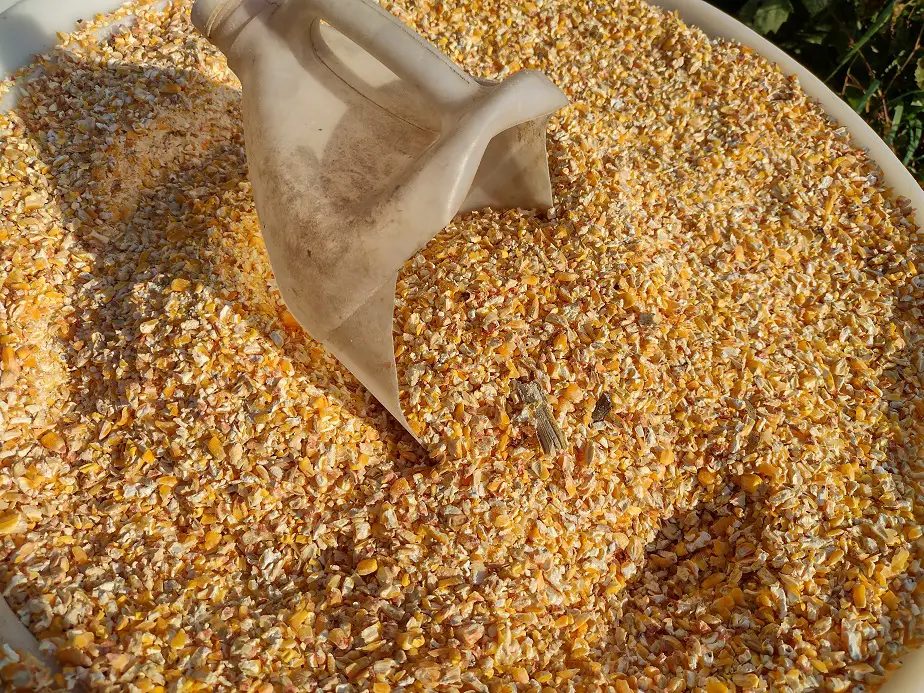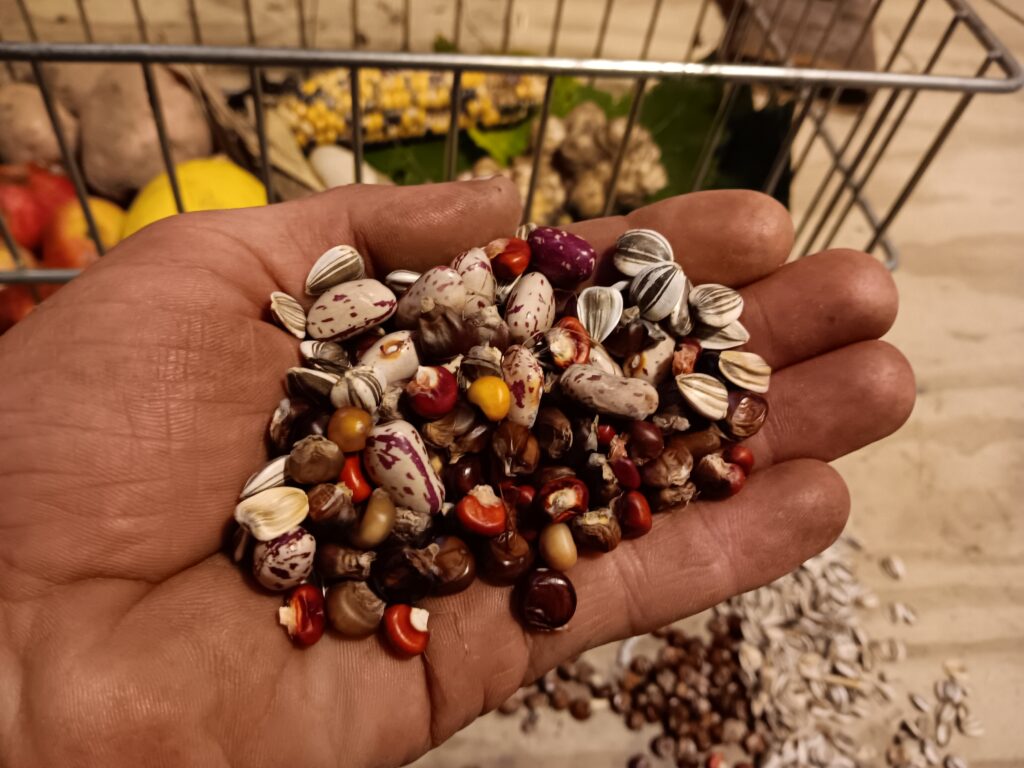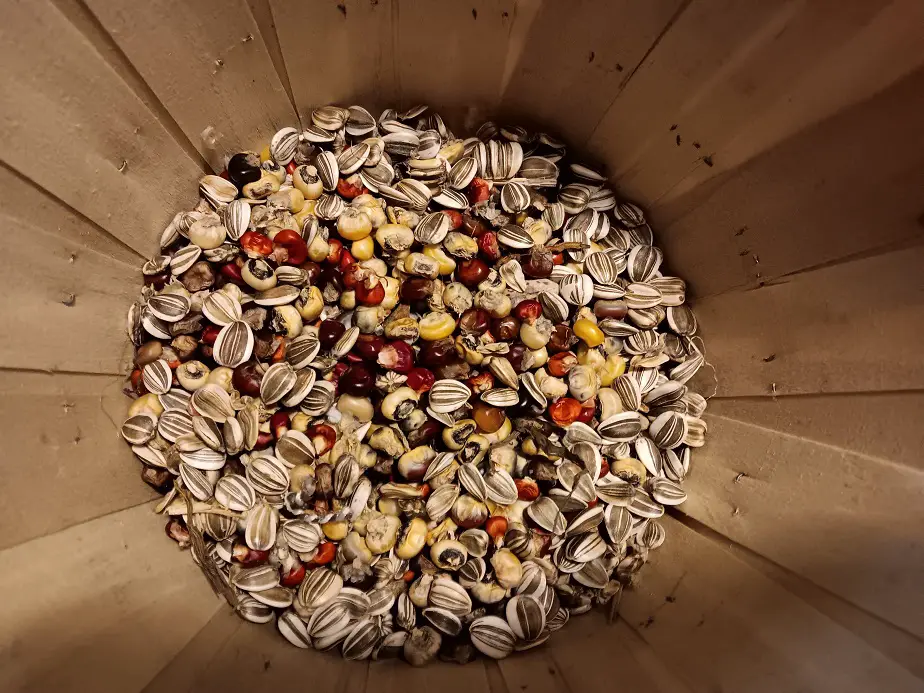Alright, here are 10 different chicken feed recipes that you can make at home. To set the stage, standard chicken feed is around 80 percent corn and 20 percent soy as a base, then has minerals added depending on feed type. Also, all these ingredients are available at feed stores and at most farm supply stores.
All recipes on this page are to produce a 100-pound batch of feed.
3 Feeds Using corn and soy
- 16 percent protein: 80 pounds corn, 20 pounds roasted soybean.
- 18 percent protein: 75 pounds corn, 25 pounds roasted soybean.
- 20 percent protein: 70 pounds corn, 30 pounds roasted soybean.
*add free choice poultry minerals or 2.5 lbs calcium to each batch.
Before I go any further, I’d like to discuss minerals. All animals need an assortment of minerals that grains don’t have. We have to add supplemental minerals. The most common are crushed eggshells and crushed oyster shell. They are about 30-38 percent calcium, but not much else.
All the trace minerals needed can be supplemented through a combination of kitchen scraps and grass clippings, and from the grit they pick out of the dirt. Laying hens usually use about 2 grams of calcium daily during production season but generally to be given twice that. That’s about 2.5% of daily intake. Let’s go over this calcium chart below.
Ca supplement options
- Bone meal- 15%
- Wood ash- 23%
- Eggshells- 38%
- Crushed limestone- 30 to 40%
- Crushed oyster shell- 40%
In order for birds to eat enough calories, we generally use the stronger calcium concentrates. In order to get the 2.5% percent of calcium content in 100 pounds of feed, you’d need to add approximately:
- 7- pounds of eggshell (more bioavailable than most)
- 7-1/2 pounds crushed limestone
- 7-1/2 pounds crushed oyster shell.
- wood ash and bone meal, being lower in Ca, are not quite as functional for a high-production diet.
However, adding 1 pound of wood ash to 100 pounds of feed can supplement all the trace elements needed, just not all the calcium. You’d still need another 2+ pounds of calcium.
You could add up to 3 pounds of ash per 100 pounds of feed, which would be 30-50% of what they need. The rest could be supplemented by saving and crushing their eggshells.
But, that’s not recommended for modern commercial meat birds because they need more magnesium to support their ridiculously fast growth.

Fermented Grain Chicken Feed Recipes
*weigh all ingredients before fermenting.
- 16 percent protein: 87 pounds corn-fermented, 13 pounds roasted soybean.
- 16 percent protein: 81 pounds corn-fermented, 19 pounds roasted soybean
- 20 percent protein: 75 pounds fermented corn, 25 pounds roasted soybean.
*add free choice poultry minerals or 2.5 lbs calcium to each batch.

Soy-Free Chicken Feed Recipies
Weigh all ingredients before fermenting
- 16 percent protein: 40 pounds corn-fermented, 40 pounds oats-fermented, 20 pounds common dry bean, roasted or otherwise cooked after weighing.
- 18 percent protein: 33 pounds fermented corn, 33 pounds oats-fermented, 34 pounds common bean-fermented
- 18 percent protein: 30 pounds each of corn, barley, and common bean, and 10 pounds alfalfa meal. All fermented together.
- 20 percent protein: 5 pounds alfalfa meal, 20 pounds sunflower seed, 20 pounds corn-fermented, 20 pounds oats-fermented, 35 pounds common bean-fermented.
*add free choice poultry minerals or 2.5 lbs calcium to each batch
Fermenting Grains
To ferment grains for chickens, fill a container 2/3 with grain and fill to the top with water. Leave it in an area with an ambient temperature between 70 and 85 degrees until the water pH has lowered to 4.3. Then it’s ready to use. Fermenting increases the protein and bioavailability of nutrients in the grains.
Beneficial Supplements for Chicken Feed
Biochar
Biochar is a type of activated charcoal used in agriculture. When added to a poultry diet at a rate of 1/2 percent, it increases nutrient uptake and improves a bird’s ability to thrive on a more alternative feed source. It also helps manage several intestinal pathogens such as Coccidiosis, E. Coli, Salmonella, and Listeria. It does all this as well as improving general gut health and immune response.
I am of the opinion that it should be included in most general poultry feeds on the market.
Jerusalem Artichoke
There’s one more feed ingredient that doesn’t get enough spotlight these days, and it’s jerusalem artichoke. It’s a tuber from a perennial sunflower native to North America. The tuber is perhaps the most beneficial probiotic nature ever sprouted.
Besides having a fine feed value, it helps clear the gut of the harmful and parasitic gut-flora including intestinal worms, and it helps to strengthen the immune system and hormone function in poultry.
When used in conjunction with biochar, the pair becomes a very impressive gut aid for all mammals and poultry. Try and find out where you can buy these feed supplements. You’ll be glad you have them.
One More Point on Chicken Feed
layers need higher protein feed if free-ranging or if you’re adding a significant amount of low-protein supplements like grass or old produce. Free range birds, even though they can get bugs, generally do not get quite as much protein as a production chicken feed contains. If you are free-ranging your birds, consider at least giving them some supplemental protein like beans, peas, or lentils.
Points to remember:
- Nutrients from living or near-living materials are more bioavailable.
- Fermentation increases nutrient bioavailability because of the increase in living matter (microbes)
- 2 to 3 percent of dietary intake should be calcium for laying hens.
If you have any questions, ask them in the comment section below.
Related Articles:

